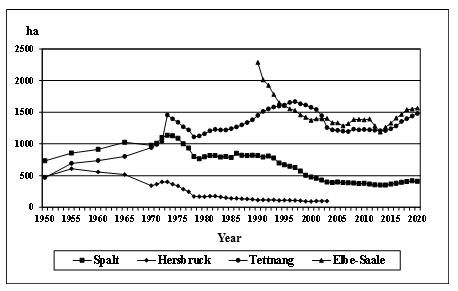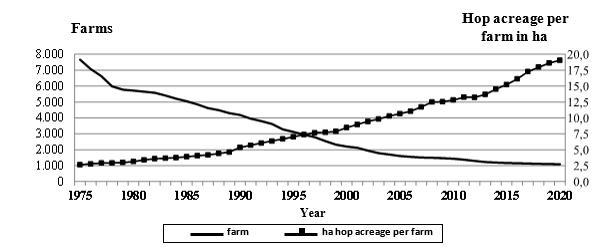
1 minute read
1 Statistical Hop Production Data

Managing Director (LD) Johann Portner, Dipl.-Ing. agr.
Advertisement
1.1.1 Structure of hop production
For statistical purposes, the Hersbruck region has been considered part of the Hallertau region, since 2004.

1.1.2 Hop varieties
With a decrease of 17 ha, the hop acreage in Germany has remained virtually constant at 20,604 ha in 2022.
The share of aroma varieties fell slightly to 52.4%, with 31 aroma varieties cultivated on 10,800 ha. Most aroma varieties have lost acreage, with Hallertauer Tradition recording the largest drop (-58 ha). In addition, the clearing of landraces and other noble varieties is continuing. The so-called "flavor varieties" are suffering the same fate, while some new aroma varieties, such as Akoya and Tango, as well as the older Perle, have been experiencing increases in acreages
The bitter hop acreage, on the other hand, rose again, this time by 181 ha. The total of 9,804 ha now accounts for 47.6% of all German hop cultivation. Again, older bitter varieties, such as Hallertauer Magnum and Hallertauer Taurus, lost acreage, while such high-alpha varieties as Herkules (+ 168 ha) and Polaris (+ 57 ha) once again gained acreage. This makes Herkules the most common Germany hop variety by far (7,142 ha), occupying more than one third of the total hop acreage
Table 1.3: Hop varieties in German growing regions in hectares in 2022
Aroma Varieties
Bitter Varieties
The 2022 German hop harvest was 34,405,840 kg (= 34,406 metric tons [MT]) and was thus significantly (-28%) below the excellent 2021 yield of 47,862,190 kg (47,862 MT). It was thus comparable to the crop failures in 2015 and 2003.
The average yield of 1,670 kg/ha is 651 kg/ha below that of the previous year. It was even worse in Spalt, where the old landrace by the same name is the predominant variety. Because Spalter hops are very susceptible to damage from drought and heat, the yield per hectare in this region was only half that of the previous year.
Likewise, the alpha acid content was also rather low. When multiplied by the low yield, older landraces and their related aroma varieties produced not even half of the amount of alpha acid of the previous year. The newer aroma and high alpha varieties, on the other hand, proved to be significantly more drought tolerant and thus suffered much smaller yield losses. Overall, the estimated amount of alpha acid produced in Germany in 2022 is roughly 3,720 MT, some 40% below the previous year's result.




